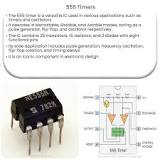555 Timer: Applications, Pinout, Pros & Cons
Catalog
555 Timer Pros & Cons
555 timer datasheet
555 timer pinout
555 timer projects
What is the advantage of 555 timer?
What are the disadvantages of 555 timer?
How to build your own 555 timer?

What are the disadvantages of 555 timer?
The disadvantages of the 555 timer are as follows:
· The frequency modulation in the 555 timer IC is not very linear.
· It is not accurate with changes in the temperature. It means that there are specified limits for the timers to operate. It does not operate accurately beyond such specified temperature ranges.
The 555 timer is one of the most popular integrated circuits for generating accurate timing pulses in electronics projects. Some key specs and details:
Pinout: The 555 timer comes in an 8-pin package with the following pins - Trigger, Output, Reset, Control Voltage (VC), Threshold (TH), and Ground.
Operation: It can operate as an astable, monostable or bistable multivibrator based on external resistor-capacitor configurations connected to relevant pins.
Applications: Common uses include building timers, oscillators, delays, stroboscopes and more. Projects range from basic to complex electronic circuits and systems.
Pros: Inexpensive, stable operation, compact size, simple interface, widespread availability make it perfect for beginner and educational projects.
Cons: Lower precision than modern timers, only allows single output mode, larger external components needed, noise susceptibility are limitations.
Datasheet: Available freely online, the datasheet provides comprehensive technical details on specifications, pin functions, operating modes, schematics etc.
In summary, the ubiquitous 555 timer is ideal for cost-effective, introductory timing applications due to its ease of use. However, modern CMOS timers offer better accuracy and multi-functional capabilities for advanced circuits.
Can you provide some examples of projects that can be built using the 555 timer?
Here are some example projects that can be built using the 555 timer:
- Burglar alarm - Can be used to generate an audible alarm output after a set time period.
- Metronome - Acts as a tempo or rhythm keeper for musical instruments by generating periodic ticks or beeps.
- Timer - Can be configured as a countdown timer to time any process/event up to hours.
- Stroboscope - Flashes an LED at adjustable rapid intervals to examine motion, cycles or rotations per minute.
- Night light - Comes on automatically after dark using a LDR sensor and turns off at dawn.
- Blinking LED circuits - Makes LEDs blink in different patterns like SOS, morse code for fun projects.
- Laser tripwire - Triggers an alarm when laser path is blocked by an intruder.
- Clapper - Detects handclaps to turn lights/appliances on/off without touching them.
- Delay circuits - Adds delay between button press to action or in sequential processes.
- Model train crossing signals - Manages flashing lights at intersections.
- Egg timer - Beeps when hard boiling time for eggs is up.
- Flame detection - Sounds alarm if fire is sensed by a heat sensor.
So in summary, the 555's timing functions lend itself to a wide variety of DIY electronic projects.
Flip-Flop: By using the bistable mode, a 555 timer can create a simple flip-flop, an essential component in digital memory circuits. Timing Delays: One of the most common applications for a 555 timer is to create a delay before an action occurs, such as turning a device on after a certain period.


















